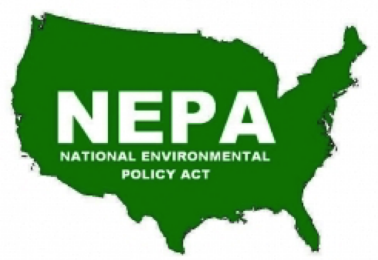Hoping to break the logjam that, for decades, has held up construction projects throughout the United States, the Trump administration on Jan. 9 rolled out sweeping reforms of the 50-year-old National Environmental Policy Act (NEPA).
To many, NEPA may not be a household name. But the statute’s Byzantine requirements have delayed, and in many cases, thwarted much-needed infrastructure projects, undermining plans to build or upgrade roads, bridges, tunnels, and pipelines. NEPA has also been used to prevent the exploration and production of oil and natural gas, as well as the mining of precious minerals.
Most Litigated Area of Environmental Law
At the same time, NEPA has enriched lawyers who have feasted on the years-long litigation the law has spawned. Indeed, NEPA is the most litigated area of environmental law, increasing costs to applicants, localities, and taxpayers.
In his remarks at the White House, President Trump — flanked by workers in hard hats and construction vests — noted that, “It took four years to build the Golden Gate Bridge, five years to build the Hoover Dam, and less one year – can you believe that ? – to build the Empire State Building. Yet today, it can take more than 10 years just to get a permit to build a simple road – just a very simple road. And usually, you’re not even able to get the permit. It’s unusual when you get it. It’s big government at its absolute worst, and other countries look at us and can’t believe it.”
Signed into law by President Nixon in 1970, the law has become a tool of obstruction by environmental groups – and with great success. Federal judges have not hesitated to delay projects on the grounds that federal officials have not conducted a thorough enough review under NEPA. The resulting delays are partially responsible for the nearly $1 trillion backlog in transportation projects.
According to the White House, each year agencies assessing projects under NEPA prepare approximately 170 environmental impact statements (EIS) — detailed documents that can run to 600 pages each – and 10,000 environmental assessments that are less stringent. Agency officials involved in the EIS process have no incentives to complete them in a time fashion and have been suspected of dragging their feet to please their political allies among the environmental groups bringing suits under NEPA.
While the intent of NEPA – to assess the environmental impacts of a project – may have been noble, the law quickly became a symbol for made-in-Washington red tape. Consider these lines from Section 2 of the statute:
The purposes of this Act are: To declare a national policy which will encourage productive and enjoyable harmony between man and his environment; to promote efforts which will prevent or eliminate damage to the environment and biosphere and stimulate the health and welfare of man…
Speeding Up the Review Process
The new rules, which were written by the White House Council on Environmental Quality (CEQ), are intended to speed up NEPA’s process for preparing and approving an EIS. Under the proposed rule, it should be easier for agencies to grant categorical exclusions for privately funded projects that lack significant federal involvement and would therefore not have to receive a NEPA permit.
For projects that require an EIS, the new rules set a two-year limit to complete an EIS and a 300-page limit for the document. For projects that require a less rigorous Environmental Assessment, the page limit is 75 and the time limit is one year. However, the agency official in charge could still waive these limits.
Other key provisions intended to speed up the process include: strengthening the authority of the lead agency when multiple agencies are involved (which is usually the case); requiring that public comments be solicited earlier in the process; and, significantly, reducing the number of alternatives that must be considered to those that are economically and technically feasible.
The current regulations flush out the law by requiring that an EIS consider “direct, indirect, and cumulative” environmental impacts of a project. The new rule strikes these specific references and thereby reverts simply to the consideration of “environmental impacts.”
Climate Impacts of a Project No Longer Required in an EIS
Further, “CEQ proposes a change in position to state that analysis of cumulative effects, as defined in CEQ’s current regulations, is not required under NEPA.” This means that an EIS will not be required to include the consideration of the potential climate impacts (which are necessarily cumulative) of a project.
“Effects should not be considered significant if they are remote in time, geographically remote, or the product of a lengthy causal chain,” the proposal states.
However, it should be noted that the new language does not prohibit consideration of cumulative impacts.
The new rules are fiercely opposed by environmental groups, many of which have already announced they plan to take the administration to court over the changes. They will likely be joined by blue-state Attorney Generals. After a 60-day public comment period, which ends in early March, implementation of the rules will be tied up in court for many months or longer. Also, it is not clear how the new rules, assuming they eventually go into effect, will be able to shield future projects from the same kind of litigation that has tied up infrastructure projects throughout NEPA’s existence.
